The colourful Marshmallow Sofa not only brought Pop Art into the living room but re- interpreted the sofa. Originally released in 1956 and marketed today by the American furniture company Herman Miller this unconventional sofa can be considered a symbol of Modern and Contemporary Design.
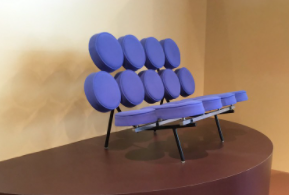
Image source: https://search.creativecommons.org/photos/c2e54542-f476-4c8e-b53c-6dcba4747cb8 by MichaelSteeber
Unconventional
The unconventional sofa is constructed from a steel structure and 18 round cushions reminiscent of the marshmallows, and which thus bequeath the name. George Nelson‘s Marshmallow Sofa transforms the traditional sofa into a playful three-dimensional object with eighteen colourful cushions attached to a simple steel frame. Due to the unusual form and construction of the Marshmallow Sofa, it is one of the most extraordinary sofas in the history of design.
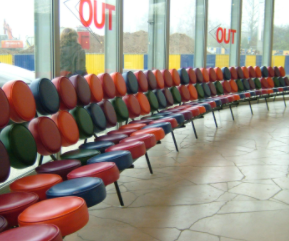
Image source: https://en.wikipedia.org/wiki/Marshmallow_sofa#/media/File:Circular.jpg
An extension element with six additional cushions can be mounted between two sofa units, making it possible to create a sofa of indefinite length. The individual cushions are upholstered with a robust vinyl cover.
Info source: https://www.vitra.com/en-hu/product/marshmallow-sofa
History of the project
The design was created in 1954 when a salesman for a Long Island plastics company presented to George Nelson’s New York City studio an example of the company’s ability to create round, 12-inch foam discs that became “self-skinned”. The limited manufacturing costs made the item inviting, and designer Irving Harper was asked to design a piece of furniture around the discs. Over a weekend Harper designed a sofa, incorporating 18 of the discs arranged over a metal frame. The invention did not live up to its promise, as covering the individual seat pads proved costly and time-consuming, turning the intended budget piece into a luxury product. Nevertheless, Herman Miller went ahead with the sofa’s production, and introduced it in 1956.
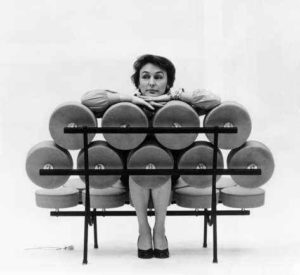
Image source: http://www.georgenelsonfoundation.org/george-nelson/index.html#featured/marshmallow-sofa
The Marshmallow sofa was designed in 1954 by Irving Harper. For decades the design of the Marshmallow sofa was attributed to George Nelson, as was the practice for designs coming out of George Nelson Associates, Inc. However, it was later revealed that many of the firm’s designs were actually those of other designers working for the firm. John Pile, a designer who worked for George Nelson Associates, Inc. in the 1950s explained:
“George’s attitude was that it was okay for individual designers to be given credit in trade publications, but for the consumer world, the credit should always be to the firm, not the individual. He didn’t always follow through on that policy though.”

Image source: https://en.wikipedia.org/wiki/George_Nelson_(designer)#/media/File:George_Nelson_portrait.jpg
Info source: https://en.wikipedia.org/wiki/Marshmallow_sofa
Design
George Nelson and Irving Harper, a young designer working in Nelson’s design firm, were approached by an inventor who had created an injection plastic disc that he insisted could be produced inexpensively and would be durable. The designers took a look and arranged 18 of them on a steel frame—the origin of the Marshmallow sofa.
The Marshmallow sofa was designed in the “atomistic” style seen in other classic George Nelson Associates designs, such as the “Ball clock” (1950) and the “Hang-It-All” (1953). The “atomistic” style explodes its parts into separate, brightly colored elements, in this case the seat cushions. It was an adaptation of artist’s representations of the atom, which used individual, brightly colored dots to portray atomic particles.
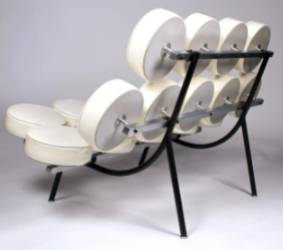
Image source:https://www.1stdibs.com/furniture/seating/sofas/early-marshmallow-sofa-george-nelson-herman-miller/id-f_14040622/
The inventor’s cushions turned out to be impractical, but Nelson and Harper were intrigued by the design they had created so casually, and Herman Miller decided to manufacture the sofa. By joining separate elements and making them appear to float on air, Nelson and Harper achieved this sofa’s unique appearance and eye-catching appeal, which led the way into the pop art style of the 1960s.
Info source: https://www.hermanmiller.com/products/seating/lounge-seating/nelson-marshmallow-sofa/design-story/
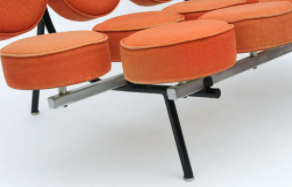
Image source: https://www.1stdibs.com/furniture/seating/sofas/george-nelson-marshmallow-sofa/id-f_693416/
Data sheet
Designer: Irving Harper of George Nelson Associates.
Year: 1956
Manufacturer: Herman Miller
Material:
- Frame: rectangular steel tubing, painted black
- Cushion covers: vinyl in dark red, orange, green, purple and blue
Dimensions: 79.38 cm x 133.35 cm x 79.38 cm
Info source: https://www.sfmoma.org/artwork/97.211
